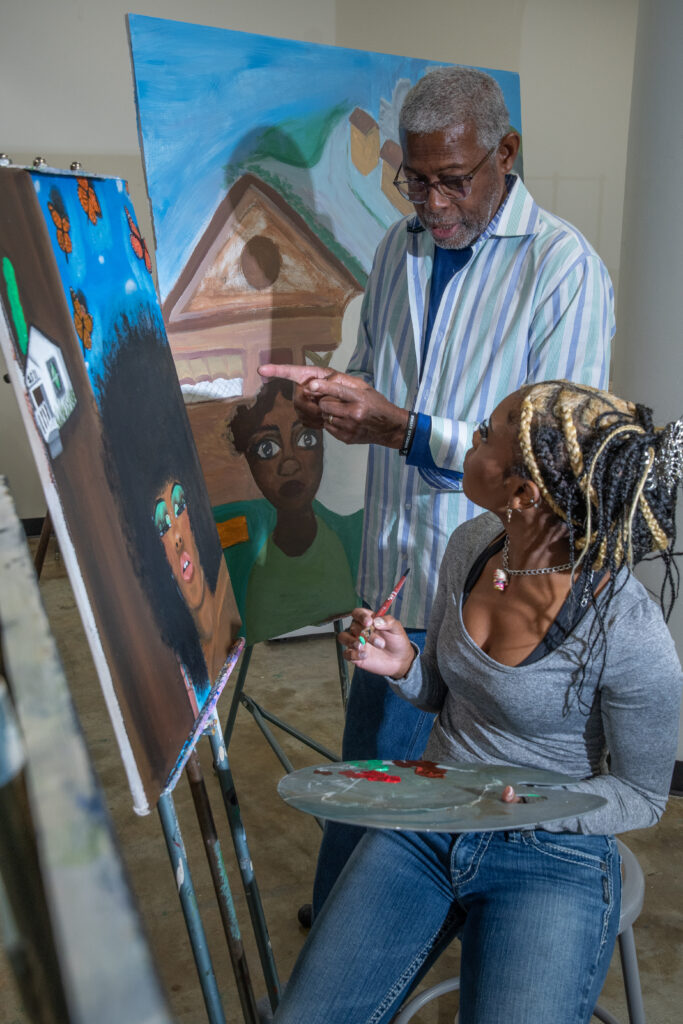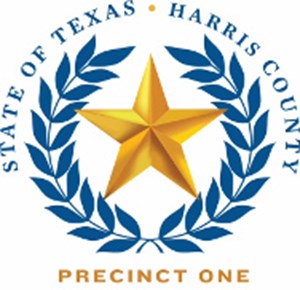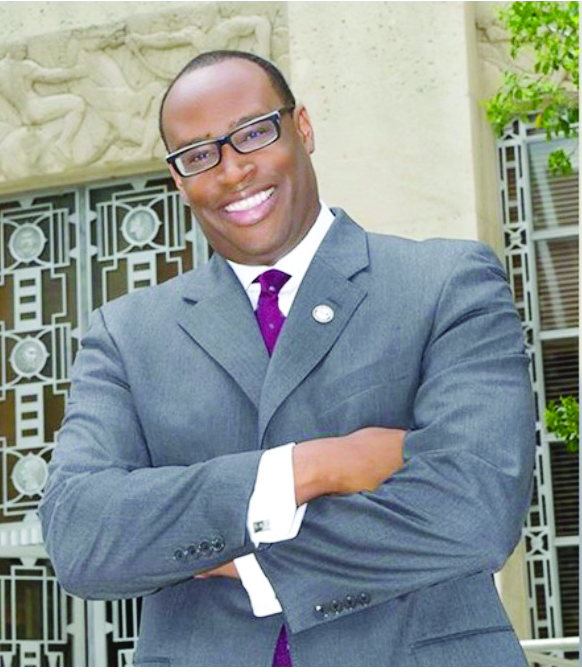
| The University of Houston-Downtown Mourns the Loss of Visionary Art Professor Floyd Newsum |
| “Professor Newsum was more than an artist, more than a teacher,” said UHD President Loren J. Blanchard. “He was a connector, a motivating force who worked to touch lives every day and who brought people together in remarkable ways. His art was intricately linked with his desire to nurture young artists and invest in the next generation of change agents, not only here at UHD but also in the historic Third Ward of Houston and even in communities he visited when his art was on view.” Born in Memphis, Tennessee, Professor Newsum graduated from Memphis College of Art with a BFA in 1973 and from Temple University, Philadelphia, Pennsylvania, with an MFA in 1975. He joined the UHD faculty in 1976, and over the years taught a variety of courses, including drawing, painting, printmaking and art appreciation, among others, in addition to coordinating the studio sections for UHD’s Art Department. In 2003, Professor Newsum received UHD’s Scholarship/Creativity Award in recognition of his contributions to visual art across a variety of media and thematic investigations. During his tenure at UHD, Professor Newsum created a wide range of work as a major local artist with a profound impact on the national contemporary visual arts scene. His work is part of permanent collections at the Smithsonian National Museum of African American History and Culture in Washington D.C., the Museum of Fine Arts in Houston, and the Philadelphia Museum of Art.His numerous public art commissions include two Houston Metro Light Rail Station art designs, seven sculptures for Houston’s Main Street Square Station, four paintings in the UHD Commerce Street Building, a suspended sculpture for the lobby of the Acres Home Multi-Service Center in Houston, a relief sculpture in the Cathedral Atrium at Wheeler Avenue Baptist Church in Houston and five suspended sculptures for the lobby of the Hazel Harvey Peace Building in Fort Worth, Texas. His work has been displayed in more than 100 exhibitions across the United States, including the University of Maryland College Park, Taft Museum in Cincinnati, the Contemporary Arts Center in New Orleans, the Studio Museum in Harlem, and the Museum of Fine Arts Houston. Professor Newsum was one of seven visionary African American artists who founded Project Row Houses (PRH) in the Third Ward in 1993. PRH is the nationally known nonprofit organization originally comprised of 22 Row Houses that “succeeds as a social sculpture when Black art, culture, and community are protected, promoted, elevated, and celebrated in new and vibrant ways.”As a co-founder of PRH, Professor Newsum worked with James Bettison, Bert Long Jr., Jesse Lott, Rick Lowe, Bert Samples, and George Smith to build an integral part of the arts community in the Third Ward, using row houses that were once modest homes for a rising affluent Black community. The co-founders established programs that not only supported Black art and culture but also built community. Professor Newsum’s dedication to community engagement remained a central part of his personal mission throughout his career.From May through October 2023, Professor Newsum received his first large-scale retrospective, “Evolution of Sight,” at the Madison Museum of Contemporary Art in Madison, Wisconsin. The exhibition was organized by guest curators Dr. Lauren Cross, Gail-Oxford Associate Curator of American Decorative Arts at The Huntington in San Marino, California, and Mark Cervenka, UHD Professor of Art and O’Kane Gallery Director. “Evolution of Sight” reflected on the artist’s entire practice, including paintings and models of public art commissions such as sculptures and relief installations, with each work transmitting the deeply personal history of the artist including symbolic references and often family photographs—all veiled by richly layered color and textures that create tactile surfaces. Newsum explained: “My career covers 50-plus years of creating works of art that are exploring color, marks, and surfaces in various mediums. I call my evolution in creativity a problem-solving event of expression of the soul.”UHD is planning a number of tributes in his memory, including an endowed scholarship: the Floyd Newsum Visionary Artist and Humanitarian Scholarship with a focus on art and social justice that will be available to students pursuing Art or Social Work degrees. Contributions for this scholarship may be made at https://giving.uh.edu/UHD/Newsum-Scholarship. At the time of the “Evolution of Sight” exhibition, co-curator Mark Cervenka stated, “A comprehensive museum exhibition of Floyd Newsum’s art is long overdue. With a career emerging from the heart of the Civil Rights Movement in Memphis in the 1960s, Newsum’s layered works have consistently included both overt and subtle responses to civil rights issues. Newsum’s father, one of the first African American firefighters in the South, set an example and provided the impetus for one of Newsum’s primary symbols in the form of a ladder.” “A bold often intensely colored palette, sometimes offset with collaged elements,” continued Cervenka, “provides a foundation both for works addressing broad cultural observations and those seeking the more intimate focus of spiritual awareness and a profound recognition of love and family.”In keeping with that description of his artistic vision, Professor Newsum will be best remembered by his colleagues, friends and students at the University of Houston-Downtown for his deep spirituality, sense of joyful purpose, and the love that he unselfishly shared with all who knew him. For more information, please visit uhd.edu. ABOUT THE UNIVERSITY OF HOUSTON-DOWNTOWNCelebrating its 50th anniversary in 2024, the University of Houston-Downtown (UHD) is the second-largest university in Houston and has served the educational needs of the nation’s fourth-largest city since 1974. As one of four distinct public universities in the University of Houston System, UHD is a comprehensive, four-year university led by President Loren J. Blanchard.UHD educates approximately 12,000 students annually, boasts more than 67,000 alumni, and offers 45 bachelor’s degrees, 12 master’s degrees, and 19 online programs within four colleges: Marilyn Davies College of Business, College of Humanities and Social Sciences, College of Public Service, and College of Sciences and Technology. UHD has one of the lowest tuition rates in Texas.U.S. News and World Report ranked UHD among the nation’s Best Online Bachelor’s Programs for Applied Administration and Best Online Master’s Programs in Criminal Justice, as well as a Top Performer in Social Mobility. The Wall Street Journal/College Pulse ranked UHD one of the best colleges in the U.S. for its 2024 rankings, with notable distinctions: No. 1 for diversity (tied) and No. 3 for student experience. TheStockWatcher.com called UHD a “notable institution providing high-quality online MBA programs. … UHD ensures that its graduates are well-prepared to succeed in their chosen career paths.”The University is designated as a Hispanic-Serving Institution, a Minority-Serving Institution, and a Military Friendly School. For more information on the University of Houston-Downtown, visit uhd.edu. |

 The 40-year-old neighboring town 30 miles South of Houston started the day with a tragic domestic terrorist attack allegedly by a 17-year old student at his Santa Fe High School of about 1,400 students. The high school serves a population of about 12,200 (US 2010 Census) residents in the rural town of Santa Fe, (Holy Faith in Spanish) in Galveston County. Police sources have stated that a young man has been placed in custody and nine people are dead while others have been taken to the League City Hospital and the UT Medical Center in Galveston.
The 40-year-old neighboring town 30 miles South of Houston started the day with a tragic domestic terrorist attack allegedly by a 17-year old student at his Santa Fe High School of about 1,400 students. The high school serves a population of about 12,200 (US 2010 Census) residents in the rural town of Santa Fe, (Holy Faith in Spanish) in Galveston County. Police sources have stated that a young man has been placed in custody and nine people are dead while others have been taken to the League City Hospital and the UT Medical Center in Galveston.

 Dr. Robert D. Bullard, distinguished professor of urban planning and environmental policy at TSU, was ranked 11th in the top 25 rankings of urban planning faculty in the United States and Canada. Professor Bullard’s book,
Dr. Robert D. Bullard, distinguished professor of urban planning and environmental policy at TSU, was ranked 11th in the top 25 rankings of urban planning faculty in the United States and Canada. Professor Bullard’s book,  Responding to the devastation of the epic and historic Hurricane Harvey, the Houston League of BUsiness and Professional Women, Inc in collaboration with The Houston Sun has established a three tier HLBPW Harvey Care Initiative. To that end, the Houston League during the conference call explored the following:
Responding to the devastation of the epic and historic Hurricane Harvey, the Houston League of BUsiness and Professional Women, Inc in collaboration with The Houston Sun has established a three tier HLBPW Harvey Care Initiative. To that end, the Houston League during the conference call explored the following: